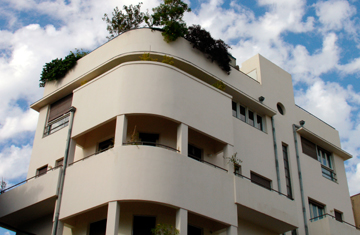
MEDITERRANEAN MODERN: In Tel Aviv, the strict principle of Bauhaus were softened by contact with a warm and lively port
The Bauhaus buildings in Tel Aviv — all 4,000 of them — are easy to spot. Built from the 1930s to the 1950s, they are curvilinear and sleek like the first-class decks of ocean liners. It's as if a fleet of dazzling white ships had sailed in from the Mediterranean and kept right on going before dropping anchor along Tel Aviv's leafy boulevards.
This is Tel Aviv's centenary year, so the boisterous Israeli seaport is in even more of a party mood than usual. And there are few better ways to celebrate the city than by strolling around its Bauhaus-style landmarks, stopping off at a few sidewalk cafés and restaurants along the way. Tel Aviv's Bauhaus buildings open the door to the mind-set of the early Zionists who went on to create the Jewish nation in 1948. They are elegant 1930s socialism writ in concrete. Many Israelis quip that the dwellings have survived in better shape than the ideals of the nation's founders. (See TIME's Global Adviser for exotic, beautiful and interesting getaways.)
When waves of Jewish immigrants arrived in the 1930s, escaping the rise of Nazism and persecution in Europe, Tel Aviv had to expand to accommodate them. Back then, it was the ancient Arab port of Jaffa, with a few Jewish settlements trying to take root in the nearby swamps and sand dunes. Most of the arriving immigrants were young, poor but fairly well educated and idealistic, and Tel Aviv's city planners sought an egalitarian architectural style in sync with the socialistic winds sweeping through Europe. They turned to Bauhaus. Founded in Weimar in 1919, the International or Bauhaus style rejected the monumental wedding cakes, dripping with decoration, that prevailed in late 19th century architecture. The movement's leaders — Walter Gropius followed by Ludwig Mies van der Rohe — sought a new holy grail in design: the unity of form and function, expressed in ways that were modern, simple and sparse.
Tel Aviv was to prove a perfect laboratory for Bauhaus, after urgent tinkering. The young Jewish architects who arrived from Germany, Poland and Russia with blueprints tucked under their arms were used to gloomy winter climes where sunlight was as rare as gold. In Europe, designs were made to trap sunlight, not block it. All that changed on the Palestine Mandate's dazzling shores, where designers realized that the fierce sun and parboiling heat were to be shunned. Gone were the big windows, replaced by narrow strips. Rooftops were given shade, balconies grew overhangs and designs were retooled to let the cool sea breezes meander through. Call it Mediterranean Modern. (See pictures of 60 years of Israel.)
Not all the Bauhaus buildings have weathered a half-century's pounding by Tel Aviv's sun and corrosive sea air. Over the years, developers walled in balconies and slopped a few extra floors on top of these once perfect structures. But after the city was declared a UNESCO World Heritage Site in 2003, Tel Aviv chose over 1,000 of these buildings for preservation and ordered that they be restored to their original shape.
The city is crisscrossed by dozens of streets lined with Bauhaus beauties, so take your pick. Our walk started at the old kiosk on Rothschild Boulevard — a city landmark and a favorite rest stop for late-morning dog walkers. Strolling up the boulevard, we passed more than a dozen Bauhaus buildings with their trademark details, such as the "thermometer" (a glassed-in stairwell rising up the side of the edifice) and the rounded balconies on which you expect a ship's captain and a socialite to appear with martinis. Taking the nautical look to extremes, a few Bauhaus buildings even have a row of portholes running along the side. The clean Modernist lines are usually set off by palm trees, or explosions of magenta and tangerine bougainvillea — a tropical extravagance of color that Gropius and Mies never would have dreamed of in their wintry Weimar. We trust that the dour old minimalists would have approved.
Got an awful travel gripe? The Avenger may be able to sort it out for you. Click here to tell us your problem.
